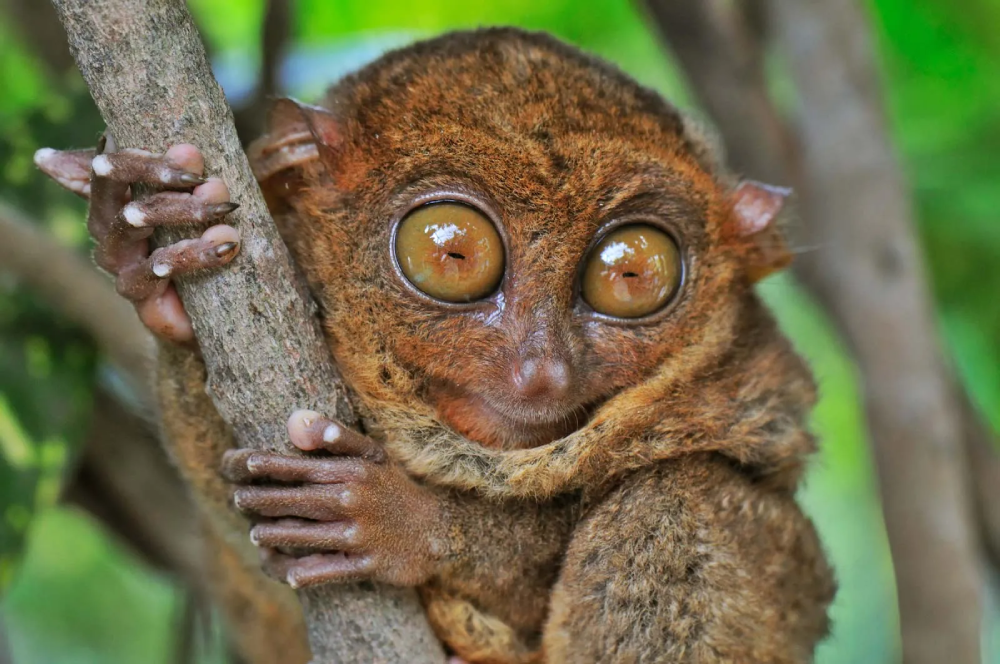The Philippine tarsier (Carlito syrichta) is a small primate that has captivated the imaginations of nature enthusiasts and scientists alike. Known for its distinct physical features and enigmatic behaviors, this tiny creature, endemic to the Philippines, offers a fascinating glimpse into the diversity of life in the archipelago’s tropical rainforests.
Physical Characteristics
The Philippine tarsier is one of the world’s smallest primates, measuring only about 3.35 to 6.30 inches (85 to 160 mm) in height, excluding its tail, which can be nearly twice the length of its body. Despite its diminutive size, it has a striking appearance. Its large, round eyes, which are disproportionately huge relative to its head, are its most defining feature. Each eye is approximately 16 mm in diameter, allowing for exceptional night vision—a crucial adaptation for its nocturnal lifestyle.
The tarsier’s body has a fine, velvety fur that ranges in color from gray to brown, providing effective camouflage against the forest backdrop. Its long fingers and toes, with adhesive pads, are perfect for grasping and leaping between branches. The tarsier’s legs are particularly noteworthy, as they are elongated and highly flexible, enabling it to leap up to 40 times its own body length in a single bound.

Habitat and Distribution
The Philippine tarsier is found primarily in the southeastern part of the Philippines, with significant populations on the islands of Bohol, Leyte, Samar, and Mindanao. Its preferred habitat is the dense, primary and secondary lowland forests, where it can find ample cover and a rich supply of insects and small vertebrates to feed on.
The tarsier’s habitat preference is crucial for its survival. It relies on the complex structure of the forest, with its intertwining vines and dense foliage, to evade predators and hunt for food. Deforestation and habitat destruction pose significant threats to its survival, leading to a decline in its population.
Behavior and Diet
Tarsiers are solitary animals, with each individual maintaining a distinct territory. They communicate through a series of high-pitched calls and ultrasonic vocalizations, which are beyond the range of human hearing. These calls play a crucial role in mating and territorial disputes.
Their diet primarily consists of insects such as crickets and grasshoppers, but they are also known to hunt small vertebrates, including birds, bats, and snakes. The tarsier’s hunting technique is a remarkable display of precision and agility. With its keen sense of sight and hearing, it can detect even the slightest movement of prey in the dark. Once it locks onto a target, it uses its powerful legs to pounce with incredible speed and accuracy.
Reproduction and Lifespan
The breeding season for the Philippine tarsier typically occurs during the months of April to May. Females give birth to a single offspring after a gestation period of about six months. The newborn tarsier is relatively well-developed at birth, with its eyes open and the ability to cling to branches.
Parental care is primarily the responsibility of the mother, who nurses the young for about two months. The young tarsier starts to hunt independently at around 80 days old but continues to stay close to its mother for several more months before establishing its own territory.
In the wild, Philippine tarsiers have a lifespan of approximately 12 to 20 years. Though, this can significantly reduce in captivity due to stress and improper care.
Conservation Status
The International Union for Conservation of Nature (IUCN) lists the Philippine tarsier as Near Threatened. The primary threats to its survival are habitat destruction, hunting, and the illegal pet trade. The rapid expansion of agricultural lands and urban development has led to significant loss of forest cover, fragmenting the tarsier’s habitat and making it more vulnerable to predators and human activities.
Conservation efforts have been implemented to protect the tarsier and its habitat. In Bohol, for instance, the Philippine Tarsier Foundation has established a sanctuary that provides a protected environment for these primates. Ecotourism also plays a role in conservation, raising awareness and generating funds to support protective measures. However, it is crucial that tourism is managed responsibly to avoid causing stress to the animals.
Cultural Significance
The Philippine tarsier holds a special place in Filipino culture and folklore. It is often regarded as a symbol of the country’s rich biodiversity and natural heritage. In some local traditions, the tarsier possesses mystical qualities, and its large, expressive eyes have inspired many legends and stories.
Conclusion
The Philippine tarsier is a remarkable example of the unique and diverse wildlife found in the Philippines. Its distinct appearance and intriguing behaviors make it a subject of fascination and a crucial species for conservation efforts. Protecting the tarsier and its habitat not only helps preserve this extraordinary primate but also contributes to the broader goal of conserving the rich biodiversity of the Philippine rainforests. As awareness and conservation efforts continue to grow, there is hope that future generations will be able to witness the charm and wonder of the Philippine tarsier in its natural environment.









